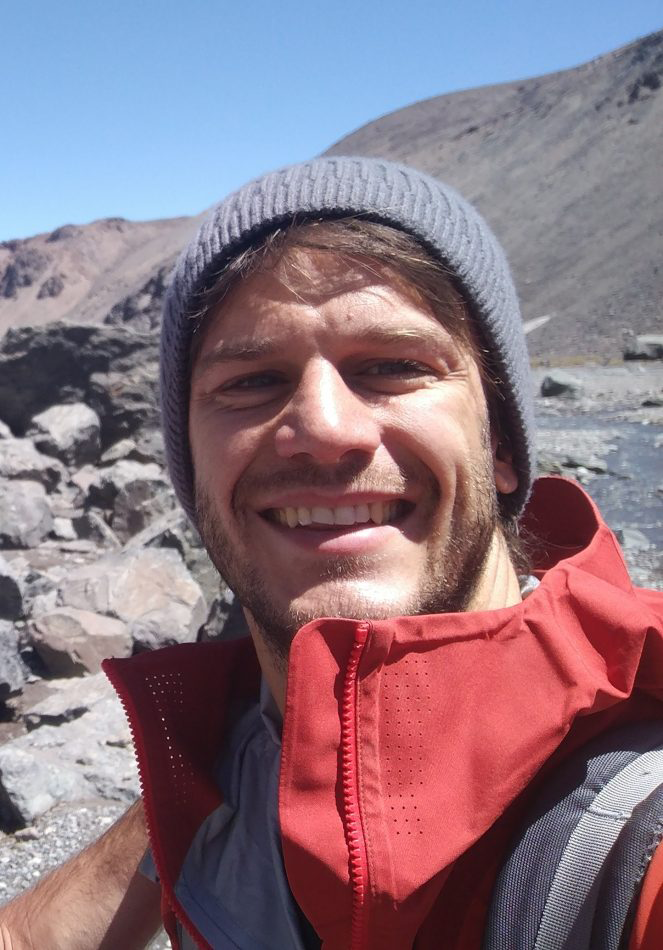Hugo Messias: a Portuguese astronomer in Chile
The Portuguese researcher was part of the large international team that revealed to the world the first image ever obtained of the shadow of a black hole. Nowadays he is still investigating the universe at ALMA.
There was a moment in the life of Hugo Messias where the balance might have tipped in favor of a career in arts, but when the memory is unraveled, it’s easy to realize that his destiny had been traced for a long time. Although he recalls being hesitant between science and art, there are several moments in the childhood of the now Portuguese astronomer working at ALMA (Atacama Large Millimeter Array) that make it easier to understand that a path was already outlined.
One evening, at a colleague’s house, someone showed him that that bright spot in the sky was Venus and Hugo remembers “the thrill of being able to teach something to other people”. Years later, his parents gave him a telescope, which he used for the first time at his grandparents’ house in Ribatejo: “From the moment you pinpoint the first two stars and discover that they are planets, after all, you realize the excitement of the discovery”. Such excitement still makes a difference every day: “Curiosity will hold you in this area. Only personal or societal issues may draw you away from the astronomy area. I cannot imagine someone getting fed up with astronomy.”
This is mainly because Hugo Messias is already the holder of one of the most fascinating recent discoveries of humanity. Three years ago, he was one of nearly 200 scientists who worked to unveil one of science’s greatest mysteries, providing the world with the first-ever photograph of the shadow black hole.
“I first arrived at ALMA in 2016 and by January 2017 I was with the team that carried out the EHT [Event Horizon Telescope]” test observations targeting the center of the Messier 87 galaxy, 55 million light-years from Earth. “I was in the right place at the right time and got involved with the right people”, he now recalls from his home in Santiago de Chile. But luck means a lot of work, and in addition to the years of study, there are also the long hours spent “preparing and making the observations, preparing the code that would let us know which reference antennas were best to use, among other tasks”.

Hugo first arrived at ALMA in 2016. © DR
Hugo was one of the astronomers that operated ALMA to observe the Messier 87 galaxy with the other seven EHT stations. The antennas are actually radio telescopes, each weighing 100 tonnes, placed 5,000 meters high, in the arid Chajnantor plateau region, east of San Pedro de Atacama.
Having a degree (Physics, Astronomy/Astrophysics area) and a Ph.D. from the Faculty of Science of the University of Lisbon, Hugo Messias left in 2011 for the University of Concepción, in Chile, where he completed a post-doctorate. He returned to Portugal two years later, with a grant from the Foundation for Science and Technology, as the scientist in charge at the Portuguese Competence Centre for ALMA. While promoting the use of ALMA data by the Portuguese scientific community, he also gave “a small share” of his time to scientific research, particularly focused on the gas and dust properties of dusty starbursts.
Hugo eventually returned to Chile, this time to live in the capital, but travelling a lot to the Atacama Desert. It was then that he joined ALMA’s Very Long Baseline Interferometry (VLBI) group and helped make history. The photograph of the black hole would be published when he was nearly finishing his third post-doctorate, without knowing how the future would be written, but the amazement brought by that moment already belonged to him.
“From the way we perceived society, in general, getting excited about the result of the research, we realized that what we had done went far beyond what we had ever seen before,” states Hugo Messias. To stress that point, he says that usually an “exciting” discovery for astronomers “will last with other people for two or three days”. “Then we showed the first image of the shadow of a black hole and found out how that lasted well over a week.” Hugo would also be awarded the Chilean State Medal and GQ Men of the Year award, in the Science category, in 2019.
Hugo has been living in Santiago de Chile since January 2020 – after having spent a few months in Portugal with his wife and his one-year-old son. Unlike what one might think, he works “mostly during the day”, spending about 70% on technical work and the rest on research.
When he is not preparing or observing from ALMA, when he is not doing his own research in Gas and Dust properties in dusty galaxies with explosive star formation with strong radio emission, Hugo contributes to the dissemination of astronomy, both in Chile and Portugal. He is a member of the education and heritage department of the International Astronomical Union, he cooperates with awareness activities promoted by ALMA and ESO in Chile, and he cooperates with the Portuguese Ciência Viva and continues to participate in activities created by Instituto de Astrofísica e Ciências do Espaço for the public at large.
And finally, when stars are not filling his mind, he practices judo, dances the tango and forró, and goes hiking in the mountains surrounding Santiago de Chile. “The worst part in Santiago is that it has seven or eight million people and the best part is that there are mountains just outside. In 25 minutes I am taking a walk that may lead me to 2,500 or 5,000 meters high.”
